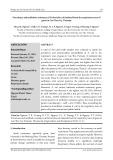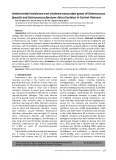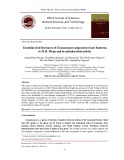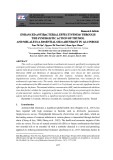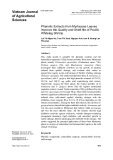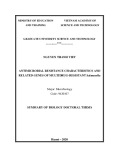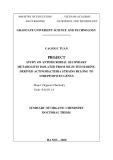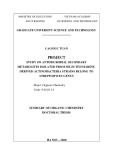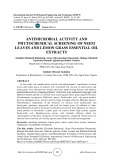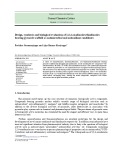Identification of ATP-NADH kinase isozymes and their contribution to supply of NADP(H) in Saccharomyces cerevisiae Feng Shi1,2, Shigeyuki Kawai1, Shigetarou Mori1, Emi Kono1 and Kousaku Murata1
1 Department of Basic and Applied Molecular Biotechnology, Division of Food and Biological Science, Graduate School of Agriculture, Kyoto University, Uji, Kyoto, Japan 2 School of Biotechnology, Southern Yangtze University, Wuxi, Jiangsu, China
Keywords ATP-NADH kinase; Pos5p; Saccharomyces cerevisiae; Utr1p; Yef1p
Correspondence K. Murata, Department of Basic and Applied Molecular Biotechnology, Division of Food and Biological Science, Graduate School of Agriculture, Kyoto University, Uji, Kyoto 611-0011, Japan Fax: +81 774 38 3767 Tel: +81 774 38 3766 E-mail: kmurata@kais.kyoto-u.ac.jp
(Received 23 August 2004, revised 25 April 2005, accepted 3 May 2005)
doi:10.1111/j.1742-4658.2005.04749.x
ATP-NAD kinase phosphorylates NAD to produce NADP by using ATP, whereas ATP-NADH kinase phosphorylates both NAD and NADH. Three NAD kinase homologues, namely, ATP-NAD kinase (Utr1p), ATP-NADH kinase (Pos5p) and function-unknown Yel041wp (Yef1p), are found in the yeast Saccharomyces cerevisiae. In this study, Yef1p was identified as an ATP-NADH kinase. The ATP-NADH kinase activity of Utr1p was also confirmed. Thus, the three NAD kinase homologues were biochemically identified as ATP-NADH kinases. The phenotypic analysis of the single, double and triple mutants, which was unexpectedly found to be viable, for UTR1, YEF1 and POS5 demonstrated the critical contribution of Pos5p to mitochondrial function and survival at 37 (cid:1)C and the critical contribution of Utr1p to growth in low iron medium. The contributions of the other two enzymes were also demonstrated; however, these were observed only in the absence of the critical contributor, which was supported by comple- mentation for some pos5 phenotypes by the overexpression of UTR1 and YEF1. The viability of the triple mutant suggested that a ‘novel’ enzyme, whose primary structure is different from those of all known NAD and NADH kinases, probably catalyses the formation of cytosolic NADP in S. cerevisiae. Finally, we found that LEU2 of Candida glabrata, encoding b-isopropylmalate dehydrogenase and being used to construct the triple mutant, complemented some pos5 phenotypes; however, overexpression of LEU2 of S. cerevisiae did not. The complementation was putatively attri- buted to an ability of Leu2p of C. glabrata to use NADP as a coenzyme and to supply NADPH.
The genomic DNA sequence of the widely studied yeast Saccharomyces cerevisiae, which is a model organism for eukaryotic cells, contains three NAD kin- ase homologues, namely, Utr1p, Pos5p and Yel041wp
[1–3]. NAD kinase (EC 2.7.1.23) catalyses NAD phos- phorylation by using phosphoryl donors (ATP or inor- ganic polyphosphate [poly(P)]), constituting the last step of the NADP biosynthetic pathway [4,5]. For the
FEBS Journal 272 (2005) 3337–3349 ª 2005 FEBS
3337
Abbreviations CgLEU2, LEU2 of yeast Candida glabrata; FOA, 5-fluoroorotic acid; GFP, green fluorescent protein; KNDE, 10 mM potassium phosphate, pH 7.0, containing 0.1 mM NAD, 0.5 mM dithiothreitol and 1.0 mM EDTA; poly(P), inorganic polyphosphate; ScLEU2, LEU2 of yeast Saccharomyces cerevisiae; SD, synthetic dextrose; SG, synthetic glycerol; SD+FOA+Ura, synthetic dextrose ⁄ 5-fluoroorotic acid ⁄ uracil; WT, wild type; YPD, yeast extract ⁄ peptone ⁄ dextrose; YPG, yeast extract ⁄ peptone ⁄ glycerol.
F. Shi et al. Saccharomyces cerevisiae NADH kinases
Results
Identification of Yel041wp (Yef1p) as ATP-NAD kinase
phosphoryl donor, the enzyme using ATP and poly(P) is termed poly(P) ⁄ ATP-NAD kinase [4] and that using ATP, but not poly(P), is termed ATP-NAD kinase [6]. For the phosphoryl acceptor, the enzyme specific to NAD is designated NAD kinase and that phosphory- lating both NAD and NADH is NADH kinase (EC 2.7.1.86) [2,3,7].
First, we attempted to identify the function of Yel041wp. We referred to Yel041wp as ‘Yef1p’ based on the designation of this protein in the SWISS-PROT (http://www.genome.ad.jp/dbget-bin/www_ database bfind?sptrembl). YEF1 consists of 1488 nucleotides encoding a polypeptide of 496 amino acid residues with a calculated molecular mass of 55.9 kDa and a calculated pI of 5.46. The YEF1 locus on genomic DNA does not contain introns.
Utr1p, which was initially identified as an ATP- NAD kinase, was proposed to participate in the ferri- reductase system [1,8]. It was required for the reduc- tion of extracellular ferric chelates to their ferrous counterparts and for the uptake of extracellular iron. three components, namely, This system consists of Fre1p, NADH dehydrogenase and Utr1p. Utr1p was proposed to contribute to the system by supplying NADP [1,8]. However, the NADH kinase activity of Utr1p has not yet been reported [1]. Pos5p was iden- tified as an ATP-NADH kinase; it was shown to be localized in the mitochondrial matrix and to be important to several NADPH-requisite mitochondrial processes, e.g. resistance to a broad range of oxida- tive stress, respiration, arginine biosynthesis, mito- chondrial iron homeostasis and mitochondrial DNA stability [2,3]. The pos5 cell exhibits poor growth in the presence of oxidative damage, glycerol as the sole carbon source and in a medium lacking arginine [2]. This mutant accumulates high mitochondrial iron and is defective in the mitochondrial Fe–S cluster-contain- ing enzymes [2]. The disruption of POS5 increases frame-shift mutations in the mitochondrial DNA [3]. However, the function of Yel041wp remains unidenti- fied.
YEF1 was expressed in Escherichia coli as a fusion recombinant protein with a V5 epitope and His6 tag at the C terminus. The fusion protein, referred to as Yef1p, consisted of 533 amino acid residues and exhib- ited the calculated molecular mass of 60.1 kDa. The cell extract of E. coli MK746 expressing YEF1 showed 0.078 UÆmg)1 ATP-NAD kinase activity, while that of control strain SK45 carrying vector alone exhibited an activity of 0.00086 UÆmg)1. When metaphosphate and polyphosphate were used at 1.0 mgÆmL)1 as poly(P) instead of ATP, no NAD kinase activity was detected, thereby suggesting that Yef1p is indeed an ATP-NAD kinase. Yef1p was purified to homogeneity from the cell extract of MK746 (Table 1). The purified enzyme migrated as a single protein band corresponding to 60 kDa on SDS ⁄ PAGE (Fig. 1A) and was eluted as a single peak, consisting of a protein of (cid:1) 480 kDa on gel filtration chromatography (Fig. 1B), thereby indicating that the enzyme was a homooctamer composed of 60- kDa subunits. ATP and other nucleoside triphosphates (especially dATP) at 5 mm were utilized by Yef1p as phosphoryl donors as follows: nucleoside triphosphates, relative activity: ATP, 100%; dATP, 91%; CTP, 43%; UTP, 14%; GTP, 13%; TTP, 6%. Poly(P)s (pyrophos- phate, tripolyphosphate and trimetaphosphate at 5 mm and polyphosphate, metaphosphate and hexametaphos- phate at 1 mgÆmL)1) and phosphorylated compounds (phosphocreatine, glucose-6-phosphate and phospho-
Table 1. Purification of Yef1p.
Although Pos5p is believed to play a significant role in NADPH biosynthesis in mitochondria [2,3], the con- tribution of Yel041wp and Utr1p to cellular function and the precise function of Yel041wp is yet to be clar- ified. In the cytosol, NADPH is mainly supplied from glucose-6-phosphate NADP by NADP-dependent dehydrogenase (EC 1.1.1.49) (Zwf1p) [9–11]. Cytosolic NADPH is required for methionine biosynthesis [2,10]. The zwf1 cell is methionine auxotrophic due to the depletion of NADPH [2,9–11], but is not arginine auxotrophic, whereas the pos5 cell exhibits arginine auxotrophy, but not methionine auxotrophy [2], thereby suggesting that NADPH is synthesized in the cytosol, separate from the mitochondria [2].
In this
study, we
identified the
Total protein (mg) Total activity (U) Yield (%) Purification (fold) Specific activity (UÆmg)1)
2808 331 218 205 100 94 1 8.0 11.4 15.1 0.9 13.4 8.5 0.078 0.619 6.1 0.886 3.9 9.475 122 Cell extract DEAE–Toyopearl Butyl-Toyopearl Ni–chelate AF Toyopearl
functions of Yel041wp (designated as Yef1p) and Utr1p as ATP- NADH kinases. We also examined the phenotypes of single and double mutants, as well as the triple mutant, which was unexpectedly viable, for UTR1, YEF1 and POS5 and attempted to clarify the roles of these three enzymes.
FEBS Journal 272 (2005) 3337–3349 ª 2005 FEBS
3338
F. Shi et al. Saccharomyces cerevisiae NADH kinases
A
B
Fig. 1. Molecular mass of Yef1p. (A) SDS ⁄ PAGE of Yef1p. Lane 1, protein markers (Bio-Rad); lane 2, purified enzyme (1.5 lg). (B) Gel filtration of Yef1p. Purified Yef1p was loaded on a Superdex 200 pg column and was eluted as described in Experimen- tal procedures. The arrow (s) indicates the elution volume (Ve) of the purified Yef1p. Protein standards (d) were as follows: (a) blue dextran 2000 (2000 kDa); (b) tyroglobulin (669 kDa); (c) ferritin (440 kDa); (d) catalase (232 kDa); (e) BSA (67 kDa); (f) ovalbumin (43 kDa); and (g) chymotry- psinogen A (25 kDa).
enolpyruvate at 5 mm) were not utilized, thereby indi- cating that Yef1p was an ATP-NAD kinase. Km for NAD and ATP were 1.9 mm and 0.17 mm, respectively.
Properties of Yef1p and identification of Yef1p and Utr1p as ATP-NADH kinases
Co2+, 32%, Ca2+, 26%. On the other hand, no activity was detected in the presence of 1 mm Zn2+, Fe2+, Cu2+, and monovalent metal ions (Na+ and Li+). NADPH and NADH slightly inhibited Yef1p; however, NADP and intermediates involved in NAD biosynthesis (nicotinic acid mononucleotide, nicotinic acid adenine dinucleotide, nicotinic acid and quinolinic acid) did not inhibit Yef1p (Table 2). HgCl2 inhibited enzyme activity (Table 2), thereby indicating the importance of the SH group of the enzyme for its catalytic activity.
The enzyme had an optimum pH of 8.5 in Tris ⁄ HCl (Fig. 2A), the optimal temperature was 45 (cid:1)C (Fig. 2B) and half of its activity was lost on treatment at 54 (cid:1)C for 10 min (Fig. 2C). Bivalent metal ions such as Mg2+, Mn2+, Co2+ and Ca2+ were indispensable for ATP- NAD kinase activity. In the presence of 1 mm metal ions, the ATP-NAD kinase activity was as follows. Metal ions, relative activity: Mg2+, 100%; Mn2+, 77%;
We also found that Yef1p exhibited NADH kinase activity in the presence of ATP, but not poly(P) (1 mgÆmL)1 metaphosphate). On assaying the NADH kinase activity of purified Utr1p [1], a similar result was obtained. Km for NADH of Yef1p was 2.0 mm
FEBS Journal 272 (2005) 3337–3349 ª 2005 FEBS
3339
Fig. 2. Effect of pH and temperature on Yef1p activity and stability. (A) Effect of pH on ATP-NAD kinase activity. NAD kinase activity was assayed by the stop method as described in Experimental procedures by using potassium phosphate (r), Tris ⁄ HCl ( ) and glycine ⁄ NaOH (m). Activity in the presence of Tris ⁄ HCl (pH 8.5) was taken relatively as 100%. (B) Effect of temperature on ATP-NAD kinase activity. NAD kinase activity was assayed by the stop method as described in Experimental procedures at indicated temperatures. The activity at 45 (cid:1)C was taken relatively as 100%. (C) Effect of temperature on the stability of Yef1p. Purified Yef1p was incubated for 10 min at indicated tem- peratures in KNDE, cooled in an ice-water bath and the residual activity was determined by the stop method as described in Experimental procedures. The activity after incubation at 30 (cid:1)C was taken relatively as 100%.
F. Shi et al. Saccharomyces cerevisiae NADH kinases
that of Utr1p was 3.5 mmÆmin)1ÆU)1; this was also similar to and higher than the Vmax value of the NAD of Yef1p (1.7 mmÆmin)1ÆU)1) and Utr1p (1.2 mmÆ min)1ÆU)1), respectively. Km and Vmax for NAD and NADH of Pos5p have not been reported [2,3].
Table 2. Effect of compounds on ATP-NAD kinase activity of Yef1p. The effect of compounds on the activity of Yef1p was stud- ied by assaying ATP-NAD kinase activity in a reaction mixture con- taining compounds at the indicated concentrations as described in Experimental procedures. The effect of NADP and HgCl2 was examined by the stop method and others, by the continuous method. Activity in the absence of each compound was taken relat- ively as 100%.
Constructions of double and triple mutants for UTR1, YEF1 and POS5
Compound Concentration (mM) Relative activity (%)
None NADPH
NADH
NADP
Nicotinic acid mononucleotide Nicotinic acid adenine dinucleotide Nicotinic acid Quinolinic acid 2-Mercaptoethanol Dithiothreitol Glutathione (reduced form) HgCl2 0.05 0.1 0.05 0.1 0.05 0.1 1.0 1.0 1.0 1.0 1.0 1.0 1.0 0.1 0.25 100 100 84 86 75 100 100 100 100 100 100 100 100 100 13 6
and that of Utr1p was 3.9 mm; this was similar to and higher than the Km value of the NAD of Yef1p (1.9 mm) and Utr1p (0.5 mm) [1], respectively. Vmax for the NADH of Yef1p was 1.9 mmÆmin)1ÆU)1 and
To examine the roles of Yef1p, Utr1p and Pos5p, we attempted to construct double and triple mutants for UTR1, YEF1 and POS5. Tables 3, 4 and 5 list the yeast strains, plasmids and primers, respectively, used in this study. We hypothesized that the triple mutant (utr1yef1- pos5) may be lethal due to the proposed significance of intracellular NADP and NADPH; therefore, we con- structed a triple mutant carrying UTR1 on YCplac33 (MK1208, utr1yef1pos5 YCp-UTR1) by replacing POS5 in MK933 (utr1yef1 YCp-UTR1) with CgLEU2 (LEU2 of Candida glabrata, GenBank ID CGU90626) and examined the viability of the triple mutant after the loss of YCp-UTR1 by using synthetic dextrose ⁄ 5-fluoro- orotic acid ⁄ uracil (SD+FOA+Ura) medium [12]. The MK1208 (utr1yef1pos5 YCp-UTR1) was able to grow in SD+FOA+Ura liquid medium as well as on the SD+FOA+Ura solid medium (data not shown). The resultant triple mutant (MK1219, utr1yef1pos5) that grew on the SD+FOA+Ura media was believed to lose YCp-UTR1 [12]. The loss of YCp-UTR1 was con- firmed by the Ura– phenotype of MK1219 (require-
Table 3. S. cerevisiae strains used in this study.
Genotype Strain Source
FEBS Journal 272 (2005) 3337–3349 ª 2005 FEBS
3340
BY4742 MK424 MK425 MK426 MK353 MK710 MK743 MK803 MK804 MK933 MK1208 MK1219 MK751 MK1223 MK1224 MK342 MK739 MK740 MK741 MK742 EUROSCARF EUROSCARF EUROSCARF EUROSCARF EUROSCARF EUROSCARF This study This study This study This study This study This study This study This study This study This study This study This study This study This study MATa leu2D0 lys2D0 ura3D0 his3D1 MATa leu2D0 lys2D0 ura3D0 his3D1 utr1::kanMX4 MATa leu2D0 lys2D0 ura3D0 his3D1 pos5::kanMX4 MATa leu2D0 lys2D0 ura3D0 his3D1 yef1::kanMX4 MATa leu2D0 lys2D0 ura3D0 his3D1 ftr1::kanMX4 MATa leu2D0 lys2D0 ura3D0 his3D1 zwf1::kanMX4 MATa leu2D0 lys2D0 ura3D0 his3D1 utr1::kanMX4 yef1::HIS3 MATa leu2D0 lys2D0 ura3D0 his3D1 utr1::kanMX4 pos5::HIS3 MATa leu2D0 lys2D0 ura3D0 his3D1 yef1::kanMX4 pos5::HIS3 MATa leu2D0 lys2D0 ura3D0 his3D1 utr1::kanMX4 yef1::HIS3 YCp-UTR1 MATa leu2D0 lys2D0 ura3D0 his3D1 utr1::kanMX4 yef1::HIS3 pos5::CgLEU2 YCp-UTR1 MATa leu2D0 lys2D0 ura3D0 his3D1 utr1::kanMX4 yef1::HIS3 pos5::CgLEU2 MATa leu2D0 lys2D0 ura3D0 his3D1 pos5::kanMX4 YEp13 MATa leu2D0 lys2D0 ura3D0 his3D1 pos5::kanMX4 pRS415 MATa leu2D0 lys2D0 ura3D0 his3D1 pos5::CgLEU2 MATa leu2D0 lys2D0 ura3D0 his3D1 YEplac195 MATa leu2D0 lys2D0 ura3D0 his3D1 pos5::kanMX4 YEp-UTR1 MATa leu2D0 lys2D0 ura3D0 his3D1 pos5::kanMX4 YEp-POS5 MATa leu2D0 lys2D0 ura3D0 his3D1 pos5::kanMX4 YEp-YEF1 MATa leu2D0 lys2D0 ura3D0 his3D1 pos5::kanMX4 YEplac195
F. Shi et al. Saccharomyces cerevisiae NADH kinases
Table 4. Plasmids used in this study. YGRC, Yeast Genetic Resource Centre, Osaka University, Japan.
Plasmid Description Source
a LEU2 of C. glabrata. b LEU2 of S. cerevisiae.
Gateway destination vector, Apr YEF1 in pET-DEST42 Gene deletion vector, HIS3, Apr Gene deletion vector, CgLEU2a, Apr E. coli ⁄ S. cerevisiae shuttle vector, URA3, 2 lm, Apr UTR1 flanking 5¢ 503 bp in YEplac195 POS5 flanking 5¢ 406 bp in YEplac195 YEF1 flanking 5¢ 503 bp in YEplac195 E. coli ⁄ S. cerevisiae shuttle vector, URA3, CEN, Apr UTR1 flanking 5¢ 503 bp in YCplac 33 E. coli ⁄ S. cerevisiae shuttle vector, ScLEU2b, 2 lm, Apr E. coli ⁄ S. cerevisiae shuttle vector, ScLEU2b, CEN, Apr Gene modification vector, GFP, HIS3, Apr Invitrogen This study [34] YGRC [13] This study This study This study [13] This study [13] [13] [29] pET-DEST42 pET-YEF1 pFA6a-His3MX6 pCgLEU2 YEplac195 YEp-UTR1 YEp-POS5 YEp-YEF1 YCplac33 YCp-UTR1 YEp13 pRS415 pFA6a-GFP(F64A, S65T, R80Q, V163A) -His3MX6
Table 5. Primers used in this study. The start and stop codons are specified in bold. The Shine–Dalgarno sequence is indicated by double underlining. The sequence corresponding to the genomic DNA sequence of S. cerevisiae is underlined.
Primer Oligonucleotide sequences
yef1-attB1FSD
yef1-attB2R attB1 attB2 yef1hisf
yef1hisr
pos5hisf
pos5hisr
pos5leu21.6f
pos5leu21.6r
yef1up0.5kb yef1-HindIII pos5up0.4kb pos5-HindIII utr1up0.5kb utr1-BamHI AAAAAGCAGGCTCCGAAGGAGATATAAAA ATGAAAACTGATAGATTACTG AGAAAGCTGGGTGGATTGCAAAATGAGCCTGAC ACAAGTTTGTACAAAAAAGCAGGCT ACCACTTTGTACAAGAAAGCTGGGT CAATAAATCTGCTTACGTGACATTTTTTACTAAAAGAGAAT ATGCGTACGCTGCAGGTCGAC GAACCCTTGACTACGGAAACGCAGGATGTGGGAAATCG TTAATCGATGAATTCGAGCTCG CATAAATAAAAGGATAAAAAGGTTAAGGATACTGATTAAA ATGCGTACGCTGCAGGTCGAC CTTAGAGAATCTCATTGAATCTTTGCATTCAGAGCGT TTAATCGATGAATTCGAGCTCG CATAAATAAAAGGATAAAAAGGTTAAGGATACTGATTAAA ATGCCAATTCTGTGTTTCCCGGAAATG CTTAGAGAATCTCATTGAATCTTTGCATTCAGAGCGT TTAGTAAAGTTCGTTTGCCGATACATG CGTTATGAAAATCACTATTATCCCC AAAAGCTTAGATTGCAAAATGAGCCTGACGA GCTATGAAAGTCAATCCTTTTAATCG GAAAGCTTAATCATTATCAGTCTGTCTCTTGG GCCACTGCCATCTCTTCCATTCTTTG ATGGATCCTTATACTGAAAACCTTGCTTGAGAAG
ment of uracil for growth; data not shown). Thus, the triple mutant was unexpectedly viable.
Growth phenotypes of mutants for UTR1, YEF1 and POS5
We examined the growth phenotypes of single, double i.e. utr1, yef1, pos5, utr1yef1, and triple mutants,
utr1pos5, yef1pos5 and utr1yef1pos5 cells. These mutants did not exhibit any severe growth defects at 30 (cid:1)C in SD, YPD, YPD high dextrose (20% glucose), YPD low dextrose (0.2% glucose) liquid media (Fig. 3) and on SD solid medium (Fig. 4A, control). However, in yeast extract ⁄ peptone ⁄ glycerol (YPG; 3% glycerol) medium, pos5 mutants (pos5, yef1pos5 and utr1pos5) showed a longer doubling time than the other single
FEBS Journal 272 (2005) 3337–3349 ª 2005 FEBS
3341
F. Shi et al. Saccharomyces cerevisiae NADH kinases
(data not shown). Growth defects of
Fig. 3. Doubling times for the growth of single, double and triple mutants for UTR1, YEF1 and POS5. The mutants and BY4742 (WT) cells that were cultivated in YPD liquid medium to saturation were washed three times in sterilized water and inoculated into 3 mL SD (2% glucose), YPD (2% glucose), YPD high dextrose (20% glu- cose), YPD low dextrose (0.2% glucose) and YPG (3% glycerol) liquid media until D600 of 0.05. The cells were cultivated aerobically at 30 (cid:1)C and their growth was monitored by following D600 every 4 h. Averages in two independent experiments are provided.
critical
slightly inhibited the growth of
the
and double mutants and the wild-type (WT, BY4742) cell, although the triple mutant (utr1yef1pos5) did not (Fig. 3). The growth defect of pos5 mutants probably reflected the mitochondrial dysfunction caused by the deletion of POS5 [2,3]. The absence of growth defects in the triple mutant suggested that CgLEU2, which was used for the disruption of POS5 in the utr1yef1 cell to construct triple mutant, can complement the growth defect of pos5 mutants.
All mutants exhibited proper growth on solid med- ium lacking methionine (data not shown), the med- the zwf1 cell ium on which we confirmed that exhibited growth defect as reported elsewhere [2,9– the pos5 11] cell on medium lacking arginine, on medium contain- ing oxidative stress (2 mm hydrogen peroxide) and on synthetic glycerol (SG) medium were previously reported [2] and confirmed in this study (Fig. 4A), thereby indicating that Pos5p is a critical contributor to mitochondrial functions [2,3]. We found that utr1- pos5 and yef1pos5 cells appeared to grow somewhat less than pos5 cells on solid medium lacking argi- nine, on solid medium containing hydrogen peroxide and on solid SG medium (Fig. 4A); this was con- firmed using liquid media lacking arginine (Table 6). However, utr1yef1 and other single mutants showed no growth defects on these solid media (Fig. 4A). These growth defects indicate that Utr1p or Yef1p can partially contribute to the mitochondrial function only in the absence of contributor the i.e. partial contribution was observed only (Pos5p), in the absence of the critical contributor. However, the utr1yef1pos5 cell exhibited no growth defects on the solid and liquid media, unlike the other pos5 thereby suggesting mutants (Fig. 4A and Table 6), that CgLEU2 can complement the growth defects of pos5 mutants. In liquid medium lacking arginine, leu- cine triple mutant (Table 6).
A
B
FEBS Journal 272 (2005) 3337–3349 ª 2005 FEBS
3342
Fig. 4. Growth phenotypes of the mutants for UTR1, YEF1 and POS5. (A) The mutants and WT cells that were cultivated in SD liquid medium to saturation were washed three times in sterilized water and spotted as described in Experimental procedures on SD solid medium (control), SD solid media without arginine (–Arg), with 2 mM hydrogen peroxide (+H2O2) and SG solid medium (SG). (B) pos5 mutants lacking ScLEU2 (pos5), carrying ScLEU2 on high copy vector (pos5 YEp13), low copy vector (pos5 pRS415) and carrying CgLEU2 on chromo- some (pos5::CgLEU2) were treated and spotted as in (A).
F. Shi et al. Saccharomyces cerevisiae NADH kinases
pos5 pRS415 cells were not detected on these solid media (data not shown).
Table 6. Doubling time of WT (BY4742) and pos5 mutants. Means of two independent experiments are provided. Arginine concentra- tions are specified in parentheses in mgÆL)1. In this study, 20 mgÆL)1 arginine was usually added. NG, No growth; ND, not deter- mined.
Doubling time (h)
Arg (0) Arg (0.2) Arg (2) Arg (20) Strains
The expression of POS5, UTR1 and YEF1 via a high-copy vector complemented the poor growth of the pos5 cell on SG solid medium and on and in solid and liquid media lacking arginine (Fig. 5 and Table 6), thereby supporting the partial contribution of Utr1p and Yef1p to mitochondrial functions (Fig. 4A).
2.1
NG NG NG
Temperature sensitivity of the mutants for UTR1, YEF1 and POS5
2.0 6.9 14.8 10.8 2.6 2.3
a This strain was grown in media lacking leucine. The other strains were grown in media containing leucine.
WT pos5 utr1pos5 yef1pos5 utr1yef1pos5 utr1yef1pos5a WT YEplac195 pos5 YEplac195 pos5 YEp-UTR1 pos5 YEp-POS5 pos5 YEp-YEF1 2.7 2.1 1.8 15.6 6.3 2.8 6.6 ND ND ND ND ND 2.2 6.1 8.8 8.8 3.2 2.3 1.9 8.5 6.0 2.8 5.8 1.9 2.9 2.6 2.7 3.1 2.2 1.9 4.0 3.1 2.7 4.9
Complementing abilities of LEU2, UTR1 and YEF1 for the growth defects of the pos5 mutant
At higher temperature (37 (cid:1)C) on SD solid medium, pos5 single mutant showed a slight growth defect, and the deletion of UTR1 or YEF1 and particularly of both UTR1 and YEF1 from the pos5 cell enhanced the (Fig. 6). However, utr1yef1 and the growth defect other single mutants did not exhibit growth defects at 37 (cid:1)C (Fig. 6), thereby indicating that Pos5p is a crit- ical contributor to the survival of the cells at 37 (cid:1)C on SD solid medium; Utr1p or Yef1p and in particular, both Utr1p and Yef1p can contribute significantly to the survival only in the absence of main contributor (Pos5p). On YPD solid medium, the growth defect was alleviated (Fig. 6).
Growth phenotypes of mutants for UTR1, YEF1 and POS5 in low iron medium
To confirm the complementing ability of LEU2 for the growth defects of the pos5 mutant, we examined the growth of pos5 cells containing CgLEU2 instead of POS5 on the chromosome, ScLEU2 (LEU2 of S. cere- visiae) on a high copy vector (YEp13) [13] and on a i.e. MK1224 (pos5:: low copy vector (pRS415) [13], CgLEU2), MK751 (pos5 YEp13) and MK1223 (pos5 pRS415), on several media on which pos5 mutants, except for the triple mutant, showed growth defects (Fig. 4A). The pos5::CgLEU2 cell was able to grow on these media, whereas pos5 YEp13, pos5 pRS415 and pos5 cells were unable to grow (Fig. 4B), thereby indi- cating that CgLEU2 on the chromosome, but not ScLEU2 on YEp13 and pRS415, could complement the growth defect of the pos5 cell. The effect of leucine on the growth of pos5::CgLEU2, pos5 YEp13 and
Because Utr1p is proposed to participate in the ferri- reductase system required for low iron uptake, the utr1 cell was expected to exhibit growth defect on the low iron medium [1,8]. As expected, utr1 exhibited lower growth in the low iron medium than the yef1 and pos5 single mutants (Fig. 7). The deletion of YEF1 or POS5 from utr1 further decreased the growth of utr1 to the same level as that of the ftr1 mutant, which lacks a high-affinity iron transporter and shows severe growth defects in the low iron medium [14] (Fig. 7). Further- more, the deletion of both YEF1 and POS5 from utr1
FEBS Journal 272 (2005) 3337–3349 ª 2005 FEBS
3343
Fig. 5. Complementation of pos5 cell. Indi- cated pos5 and WT cells carrying each gene on a high-copy vector or high-copy vector alone were treated as in Fig. 4A and spotted on SD solid media (glucose) with (control) and without (–Arg) arginine and SG solid media (glycerol) with (+Arg) and without (–Arg) arginine.
F. Shi et al. Saccharomyces cerevisiae NADH kinases
Fig. 6. Temperature sensitivity of the mutants for UTR1, YEF1 and POS5. The mutants and WT cells were treated and spotted on SD and YPD solid media as des- cribed in Fig. 4A and were grown at 30 (cid:1)C and 37 (cid:1)C as indicated.
Discussion
In this
study, we
The genomic sequence of the yeast S. cerevisiae con- tains three NAD kinase homologues, i.e. Utr1p, Pos5p and Yel041wp [1–3]. termed Yel041wp ‘Yef1p’. Among the three proteins, only the function of Yef1p was not identified biochemically; therefore, it was termed the ‘function-unknown’ pro- tein. We identified that Yef1p functions as an ATP- NADH kinase by using recombinant protein expressed in E. coli. We also confirmed that Utr1p, initially identified as an ATP-NAD kinase [1], was in fact an ATP-NADH kinase. Thus, the three isozymes of NAD kinase, namely, Utr1p, Yef1p and Pos5p, were bio- chemically identified as ATP-NADH kinases [1–3].
(a homooctamer
Fig. 7. Growth of mutants for UTR1, YEF1 and POS5 in low iron medium. In order to exhaust the intracellular iron content, the mutants and WT cells were cultivated in a low iron liquid medium to saturation and further cultivated for 24 h after a 100-fold dilution of the saturated culture by the same fresh medium. The cells were washed three times in sterilized redistilled water and inoculated into 3 mL SD (filled bar) and low iron (open bar) liquid media to give D600 of 0.05 (SD) and of 0.20 (low iron). The cells were cultivated aerobically at 30 (cid:1)C, and growth was monitored by following the D600. Bars represent the relative D600 (%) of the cultures in the sta- tionary phase (SD, after 34 h; low iron, after 100 h), taking D600 (%) of the WT cell in each medium (SD, D600 of 5.8; low iron, D600 of 2.4) as 100%. Means of two independent experiments are pro- vided.
[4,18–20]. No regulators
decreased the growth to a level that was much lower than that of the ftr1 mutant (Fig. 7). It should be noted that in the presence of Utr1p, the mutants (yef1, pos5 and yef1pos5 cells) did not exhibit growth defects (Fig. 7), thereby indicating that Utr1p is a critical con- tributor to growth in the low iron medium and that Yef1p or Pos5p and, in particular, both Yef1p and Pos5p can contribute significantly to this kind of growth only in the absence of the critical contributor (Utr1p).
Yef1p exhibited a homooctameric structure consist- ing of 60-kDa subunits, while Utr1p exhibited a homo- hexameric structure consisting of 60-kDa subunits [1]; however, the structure of Pos5p has not been deter- mined [2,3]. The homooctameric structure of Yef1p shows good agreement with that of the NADH kinase found in C. utilis consisting of 32-kDa subunits) [15] and pigeon liver NAD kinase (a homooctamer consisting of 34-kDa subunits) [16]. However, it was not in agreement with the NAD kin- ase structure of humans (a homotetramer consisting of 49-kDa subunits) [17] and that in Mycobacterium tuberculosis (a homodimer or homotetramer with 33–35-kDa subunits) for Yef1p activity were found (Table 5). Intermediates of NAD biosynthesis, particularly quinolinic acid, did not affect Yef1p, although poly(P) ⁄ ATP-NAD kinase of the Gram-positive bacterium Bacillus subtilis is acti- vated by this compound [21]. NADPH, NADH, and NADP at 0.05 mm also exerted a slight effect on Yef1p activity, although these inhibited the ATP-NAD kinase activity of Utr1p; the residual activity of Utr1p was 0%, 59% and 61% in the presence of 0.05 mm
FEBS Journal 272 (2005) 3337–3349 ª 2005 FEBS
3344
F. Shi et al. Saccharomyces cerevisiae NADH kinases
NADPH, NADH and NADP [1], respectively, thereby suggesting a difference in the regulation of Yef1p and Utr1p by these compounds.
The viability of
the triple mutant
for example,
‘function-unknown’ proteins
not
Although the critical contribution of Yef1p alone to specific cellular function was not observed in this study, a difference in the regulation of Yef1p and Utr1p by NADPH, NADH and NADP (Table 2) [1], and the different transcriptional patterns and protein– protein interactions of Yef1p, Utr1p and Pos5p [25– 27] may be indicative of a certain critical contribution of Yef1p. In brief, transcriptions of YEF1 are repressed under anaerobic conditions and in the presence of ethanol stress; however, those of UTR1 and POS5 are not affected [25,26]. Two-hybrid analysis indicated that Yef1p interacted with Utr1p (Yor315wp, and the Yhr115cp and Ykl009wp). On the other hand, Utr1p interacted with Yef1p and Nup119p (nuclear pore complex involved in nucleocytoplasmic transport), and Pos5p interacted with Gts1p (putative transcription factor) [27]. The interaction of Yef1p with Utr1p is of biological interest and may be related to the pro- nounced requirement of both Yef1p and Utr1p in the absence of Pos5p.
the triple mutant
(utr1yef1pos5)
the mitochondrial
for the three NADH kinase genes (UTR1, YEF1 and POS5) at 30 (cid:1)C was unexpected. NAD and NADH kinases have been regarded as the sole enzymes producing NADP and NADPH [5]. Accordingly, NAD kinase was recently reported to be essential to bacteria such as B. subtilis [22] and M. tuberculosis [23]. Taking into account the fact that no NAD kinase homolog other than Utr1p, Yef1p and Pos5p is found in the genome sequence of S. cerevisiae, we propose that a ‘novel’ enzyme, whose primary structure is different from those of all known NAD and NADH kinases, cata- lyses the formation of NADP or NADPH in S. cere- visiae. Furthermore, we believe that the novel enzyme was able to catalyse the formation of cytosolic NADP, but cytosolic NADPH and mitochondrial NADP(H) for the following reasons: (a) methionine auxotrophy of the zwf1 mutant [2,9–11] indicates that cytosolic NADPH is not supplied by the novel enzyme in this mutant; (b) viability and methionine prototro- phy of (data not shown) supports the possibility that cytosolic NADP, which is probably converted to NADPH by Zwf1p, is supplied by the novel enzyme; and (c) the decreased mitochondrial NADPH level in the pos5 mutant [2,3] (Fig. 4A) indicates that mitochondrial NADPH and ⁄ or NADP are not supplied by the novel enzyme in the pos5 mutant.
The viability of
the triple mutant
The elucidation of the localization of Utr1p and Yef1p would be helpful in understanding the critical contribution of Yef1p as well as the molecular mech- anism underlying the findings described in this study. The localizations of Yef1p and Utr1p were predicted by computer program analysis using ipsort [28], which detects targeting sequence and N-terminal signal sequence for targeting proteins to the ER. ipsort did not show any positive sequence in Yef1p and Utr1p, although it detected a mitochondrial targeting sequence in Pos5p [2,3], thereby implying that Yef1p and Utr1p are not, at least, mitochondrial enzymes. We attempted to examine the localization of Yef1p and Utr1p by inserting the green fluorescent protein (GFP) gene into the 3¢ terminus of YEF1 and UTR1 on the chromosome by using the pFA6a- GFP(F64A, S65T, R80Q, V163A)-His3MX6 [29] gene modification plasmid in order to express them as GFP-fusion proteins, and then observing them using fluorescence microscopy or detecting them by western blotting with anti-GFP Ig (Molecular probes, Eugene, their localization could not OR, USA). However, be confirmed, possibly due to the low expression of the GFP-fusion proteins and ⁄ or the sensitivity of the detection system.
(utr1yef1pos5) might imply that the three NADH kinases are dispen- sable (Utr1p, Yef1p and Pos5p). However, the pheno- typic analysis of the single, double and triple mutants for UTR1, YEF1 and POS5 and previous reports [2,3] showed the critical contribution of Pos5p to mitoch- ondrial functions and survival at 37 (cid:1)C, and the critical contribution of Utr1p in supporting growth in a low iron medium. The contributions of the other two enzymes were shown only in the absence of the critical contributor, which was supported by the complementa- tion of certain pos5 phenotypes through the over- expression of UTR1 or YEF1 (Figs 4A,5,6,7; Table 6). Furthermore, the alleviated temperature sensitivity of the pos5 mutants on YPD solid medium when com- pared with that on SD solid medium (Fig. 6) may be indicative of the significance of NADP and NADPH in biosynthetic reactions, which is in agreement with the well-accepted concept that NADP and NADPH are involved primarily in biosynthetic reactions, while NAD and NADH are involved primarily in catabolic reactions [24].
Finally, we also found that CgLEU2 (LEU2 of C. glabrata), but not ScLEU2 (LEU2 of S. cerevisiae), complemented certain pos5 phenotypes (Fig. 4). LEU2 encodes b-isopropylmalate dehydrogenase that cata- the oxidation of b-isopropylmalate by using lyses NAD, but not NADP [30]. ScLeu2p reportedly uses NAD, but not NADP (< 5% efficiency) [30]; it was
FEBS Journal 272 (2005) 3337–3349 ª 2005 FEBS
3345
F. Shi et al. Saccharomyces cerevisiae NADH kinases
Strains
also reported to be localized in the cytosol [31]. No positive sequence was detected in ScLeu2p during the computer program analysis using ipsort, thereby sup- porting the cytosolic localization of ScLeu2p. The co- enzyme specificity and localization of CgLeu2p have not been reported. However, ipsort did not show any positive sequence in CgLeu2p, possibly suggesting that CgLeu2p was localized in the cytosol. Collectively, we assume that cytosolic CgLeu2p has the ability to utilize NADP and that it supplies cytosolic NADPH, whereas cytosolic ScLeu2p cannot provide NADPH due to its specificity to NAD. In the triple mutant (utr1yef1pos5), cytosolic NADP might be supplied by the ‘novel’ enzyme, being different from Utr1p, Yef1p, and Pos5p, as discussed above. In this context, we assume that the adequate amount of cytosolic NADPH that is being provided by CgLeu2p is possibly transported into the mitochondria via an unidentified transporter localized in the mitochondrial membrane. This results in comple- the pos5 phenotypes caused by low mentation of mitochondrial NADPH levels [2,3], although an NADPH supply of this kind is not adequate for com- plementing the growth defects of the triple mutant at 37 (cid:1)C and in a low iron medium (Figs 6 and 7). This assumption is also supported by the complementation of pos5 phenotypes through the expression of UTR1 or YEF1 via a high-copy vector (Fig. 5 and Table 6), wherein it is implied that Utr1p and Yef1p are not mitochondrial enzymes, as mentioned above. The slight growth inhibition of the triple mutant by leucine in liquid medium lacking arginine (Table 6) might imply that the expression and ⁄ or activity of CgLeu2p are sup- pressed by leucine.
Strains of S. cerevisiae were cultured at 30 (cid:1)C in nutrient- rich yeast extract ⁄ peptone ⁄ dextrose (YPD) medium [1% (w ⁄ v) yeast extract, 2% (w ⁄ v) peptone, 2% (w ⁄ v) glucose; pH 5.0), if necessary, with 0.2 mgÆmL)1 geneticin or in syn- thetic dextrose (SD) medium [0.67% (w ⁄ v) yeast nitrogen base without amino acids, 2% (w ⁄ v) glucose, and appropri- ate amino acids; pH 5.0]. Glucose was replaced with 3% (v ⁄ v) glycerol in the synthetic glycerol (SG) medium and the YPG medium. The concentration of glucose was chan- ged to 0.2% and 20% (w ⁄ v) for YPD low dextrose medium and YPD high dextrose medium, respectively. The low iron medium was composed of 0.67% (w ⁄ v) yeast nitrogen base ferric chloride and copper sulfate, 40 lgÆmL)1 without CuCl2, 2% (w ⁄ v) glucose, 50 mm 2-morpholinoethanesulf- onic acid, pH 6.1, 1 mm ferrozine and appropriate amino acids [14]. The SD+FOA+Ura medium was composed of 0.7% (w ⁄ v) yeast nitrogen base without amino acid, 2% (w ⁄ v) glucose, 0.1% FOA, 50 mgÆL)1 uracil and appropri- ate amino acids [12]. The SD+FOA+Ura medium was similar; however, FOA and uracil were not included. In order to prepare solid media, liquid media were solidified using 2% agar. To check the growth on solid media, the cells were cultured to saturation at 30 (cid:1)C, collected, washed three times in sterilized water and diluted in water to yield A600 of 2.0, 0.2 and 0.02. The diluted cell suspensions (5 lL) were spotted on appropriate solid media. After 5 days, photographs were taken. Culture conditions for derivative strains of E. coli BL21(DE3) (Novagen, Madi- son, WI, USA) are given below. In order to serve as a host for plasmid amplification, E. coli DH5a was routinely cultured at 37 (cid:1)C in Luria–Bertani medium (1% tryptone, 0.5% yeast extract, 1% NaCl; pH 7.2) supplemented with 100 lgÆmL)1 ampicillin or 30 lgÆmL)1 kanamycin as required.
Experimental procedures
Materials
Construction of YEF1 expression plasmid and strain
tripolyphosphate,
YEF1 was amplified from genomic DNA of S. cerevisiae BY4742 with PfuUltra high-fidelity DNA polymerase (Stratagene, La Jolla, CA, USA) by using PCR and was cloned into pET-DEST42 (Invitrogen, Carlsbad, CA, to produce pET-YEF1 in accordance with the USA) manufacturer’s protocol. The primers used were as follows: yef1-attB1FSD, yef1-attB2R, attB1 and attB2. A Shine– Dalgarno sequence (GAAGGAG) with optimal spacing for appropriate translation initiation in (ATATAAAA) E. coli was inserted upstream of the start codon of YEF1 (Table 5). The use of pET-DEST42 enabled us to fuse a V5 epitope and a His6 tag to the C-terminal of Yef1p. E. coli BL21(DE3) was transformed with pET-YEF1 and pET- DEST42 to yield MK746 and SK45, respectively.
Yeast extract, tryptone, glucose-6-phosphate and NADH were from Nacalai Tesque (Kyoto, Japan). Glutamate dehydrogenase (EC 1.4.1.3), ATP, NAD, NADP and NADPH were from Oriental Yeast (Tokyo, Japan). Ferro- trimetaphosphate, zine, pyrophosphate, glucose-6-phosphate dehydrogenase and other nucleotides were from Sigma (St. Louis, MO, USA). Polyphosphate, metaphosphate, hexametaphosphate, quinolinic acid and 5-fluoro-orotic acid (FOA) were from Wako Pure Chemical Industries (Osaka, Japan). Yeast nitrogen base without amino acids was from Difco (Sparks, MD, USA), and yeast nitrogen base without ferric chloride and copper sulfate was from Q-Bio Gene (Carlsbad, CA, USA). Purified Utr1p was obtained as described elsewhere [1]. Sources of other materials are provided in the text.
FEBS Journal 272 (2005) 3337–3349 ª 2005 FEBS
3346
F. Shi et al. Saccharomyces cerevisiae NADH kinases
Expression of YEF1 in E. coli
and NADP by the addition of 12.5 U glutamate dehydroge- nase, followed by incubation at 30 (cid:1)C for 10 min. Oxida- tion was monitored by observing the decrease in A340. After the oxidation reaction was terminated by immersing the test tube in boiling water for 5 min, the amount of NADP was determined as described above. One unit (U) of enzyme activity was defined as 1.0 lmol NADPH produced for 1 min at 30 (cid:1)C in an initial reaction mixture (1.0 mL), and specific activity was expressed in UÆmg)1 protein. Vmax was determined using 1.0 U Yef1p or Utr1p, being defined by an assay of NAD kinase activity.
For YEF1 expression, MK746 was inoculated into 400 mL of Luria–Bertani medium supplemented with 100 lgÆmL)1 ampicillin and subsequently cultured at 37 (cid:1)C aerobically until D600 reached 1.2. This culture was transferred to the same medium (12.0 L), and aerobic cultivation was contin- ued at 37 (cid:1)C for 5 h until D600 reached 0.80. Isopropyl thio-b-d-galactoside was then added to a final concentra- tion of 0.4 mm, and cultivation was continued further at 37 (cid:1)C aerobically for 5 h. As a control, SK45 in 10 mL medium was treated in a similar manner.
Purification of Yef1p
Assay of NAD kinase activity
dehydrogenase,
5.0 mm MgCl2,
ATP-NAD kinase activity was assayed at 30 (cid:1)C as des- cribed previously with a slight modification [4]. In brief, the formation of NADPH was continuously measured at A340 in a reaction mixture (1.0 mL) consisting of 5.0 mm NAD, 5.0 mm ATP, 5.0 mm glucose-6-phosphate, 0.5 U glucose- 100 mm 6-phosphate Tris ⁄ HCl (pH 8.0) and an appropriate amount of enzyme. Enzyme solution of less than 100 lL was routinely added to the reaction mixture. In some cases, NAD kinase activity was also assayed by a stop method [4]. In brief, glucose- 6-phosphate and glucose-6-phosphate dehydrogenase were removed from the initial reaction mixture described above. After the reaction was terminated by immersing the test tube in boiling water for 5 min, 0.1 mL of 50 mm glucose- 6-phosphate was added to the mixture, and the amount of NADP formed was determined enzymatically with 0.5 U glucose-6-phosphate dehydrogenase. In the examination for metal ion requirements, 0.1 mL of 50 mm MgCl2 was also added to the mixture to support glucose-6-phosphate dehy- drogenase activity. One unit (U) of enzyme activity was defined as 1.0 lmol NADP produced for 1 min at 30 (cid:1)C in an initial mixture (1.0 mL), and specific activity was expressed in UÆmg)1 protein. Protein concentrations were determined in accordance with the method of Bradford [32] by using BSA as the standard.
Assay of NADH kinase activity
Yef1p was purified by measuring ATP-NAD kinase activity (Table 1). All centrifugations were conducted at 20 000 g at 4 (cid:1)C for 20 min. The cells of MK746 overexpressing Yef1p were collected and suspended in 60 mL of KNDE (10 mm potassium phosphate pH 7.0, 0.1 mm NAD, 0.5 mm dithio- threitol 1.0 mm EDTA). The cells were then disrupted by sonication by using Insonator 201 m (Kubota, Tokyo, Japan). After the sonicated cell suspension was centrifuged, the clear supernatant (cell extract) was applied to a DEAE– Toyopearl 650M column (4 · 30 cm) (Tosoh, Tokyo, Japan) equilibrated with KNDE. Yef1p was eluted with a linear gradient of NaCl (0–500 mm) in KNDE (1000 mL). Fractions containing Yef1p that were obtained on elution with 160–205 mm NaCl were combined, saturated with ammonium sulfate (11.5%), and then applied to a Butyl- Toyopearl 650M column (2.0 · 19 cm) (Tosoh) equilibrated with KNDE saturated with ammonium sulfate (11.5%). Yef1p was eluted with a linear gradient of ammonium sul- fate (11.5%)0%) in KNDE (120 mL). Fractions containing Yef1p that were obtained on elution with 9–3% ammonium sulfate were combined and, then, dialysed overnight against a nickel-chelating start buffer (500 mm NaCl, 10 mm imi- dazole, 10 mm potassium phosphate (pH 7.0), 0.1 mm NAD and 0.5 mm dithiothreitol). The dialysate was applied to a nickel-chelating AF–Chelate Toyopearl 650M column (1.5 · 6.5 cm) (Tosoh) equilibrated with the start buffer and eluted with a linear gradient of imidazole (10–500 mm) in a start buffer (50 mL). Fractions containing Yef1p that were obtained on elution with 150–220 mm imidazole were combined, dialysed against KNDE and used as purified Yef1p.
Other analyses
the test
(pH 7.8),
400 mm Tris ⁄ HCl
A reaction mixture (1.0 mL) consisting of 2.0 mm NADH, 5.0 mm ATP, 5.0 mm MgCl2, 100 mm Tris ⁄ HCl (pH 8.0) and an appropriate amount of enzyme was incubated at 30 (cid:1)C. Enzyme solution of less than 100 lL was routinely added to the reaction mixture. The reaction was terminated by the addition of 0.1 mL of 1 m NaOH followed by imme- diate immersion of tube in boiling water for 1.5 min. The mixture was neutralized by the addition of 0.3 mL neutralization solution consisting of 500 mm trieth- (pH 7.8), anolamine ⁄ HCl 25 mm NH4Cl and 25 mm a-ketoglutarate. NADH and the NADPH thus formed were enzymatically oxidized to NAD
SDS ⁄ PAGE was conducted using a 12.5% polyacrylamide gel as described elsewhere [33]. The proteins in the gel were visualized with Coomassie brilliant blue R-250. The molecular mass of the enzyme was calculated by gel filtra- tion chromatography on a Superdex 200 pg column (1.6 · 60 cm) (Amersham Pharmacia Biotech, Piscataway, NJ, USA) with A¨ KTA purifier (Amersham Pharmacia Bio-
FEBS Journal 272 (2005) 3337–3349 ª 2005 FEBS
3347
then introduced into MK743 YCp-UTR1, which was (utr1yef1), yielding MK933 (utr1yef1 YCp-UTR1). pos5 single mutant (MK425) was transformed with YEp13 and pRS415, yielding MK751 (pos5 YEp13) and MK1223 (pos5 pRS415), respectively.
F. Shi et al. Saccharomyces cerevisiae NADH kinases
Acknowledgements
tech) by using KNDE containing 150 mm NaCl as the elu- tion buffer, as recommended by the manufacturer. The molecular mass and pI of the polypeptide were calculated with the genetyx program (Software Development, Tokyo, Japan). The localization of proteins was predicted by ipsort (http://hc.ims.u-tokyo.ac.jp/iPSORT/#predict) [28], which predicts the mitochondrial targeting sequence and the N-terminal signal sequence for targeting proteins to the endoplasmic reticulum for subsequent transport through the secretory pathway.
Construction of mutants for UTR1, YEF1 and POS5
We thank Dr S. Harashima, Osaka University, for helping us receive pCgLEU2 from the Yeast Genetic Resource Centre. This work was supported in part by a Grant-in-Aid from the Ministry of Education, Culture, Sports, Science and Technology of Japan (15780212) and by the Program for Promotion of Basic Research Activities for Innovative Biosciences (PROBRAIN).
References
1 Kawai S, Mori S, Suzuki S & Murata K (2001) Molecu- lar cloning and identification of UTR1 of a yeast Sac- charomyces cerevisiae as a gene encoding an NAD kinase. FEMS Microbiol Lett 200, 181–184.
Mutants for UTR1, YEF1 and POS5 were constructed by PCR targeting [34] as follows: HIS3 flanking approximately 40 nucleotides upstream and downstream of YEF1 was amplified by PCR from plasmid pFA6a-His3MX6 by using primers yef1hisf and yef1hisr and was introduced into MK424 (utr1) using natural transformation [35] to replace YEF1 with HIS3, thereby resulting in MK743 (utr1yef1). Similarly, HIS3 flanking approximately 40 nucleotides upstream and downstream of POS5 was obtained using primers pos5hisf and pos5hisr and was introduced into MK424 (utr1) and MK426 (yef1), yielding MK803 (utr1- pos5) and MK804 (yef1pos5).
2 Outten CE & Culotta VC (2003) A novel NADH kinase is the mitochondrial source of NADPH in Saccharo- myces cerevisiae. EMBO J 22, 2015–2024.
3 Strand MK, Stuart GR, Longley MJ, Graziewicz MA, Dominick OC & Copeland WC (2003) POS5 gene of Saccharomyces cerevisiae encodes a mitochondrial NADH kinase required for stability of mitochondrial DNA. Eukaryot Cell 2, 809–820.
4 Kawai S, Mori S, Mukai T, Suzuki S, Hashimoto W,
Tamada T & Murata K (2000) Inorganic polyphosphate ⁄ ATP-NAD kinase of Micrococcus flavus and Myco- bacterium tuberculosis H37Rv. Biochem Biophys Res Commun 276, 57–63.
5 McGuinnes ET & Bulter JR (1985) NAD kinase-a
CgLEU2 flanking approximately 40 nucleotides upstream and downstream of POS5 was amplified by PCR from plasmid pCgLEU2 by using primers pos5leu21.6f and pos5leu21.6r and was introduced into BY4742 and MK933 in order to replace POS5 with (utr1yef1 YCp-UTR1) CgLEU2, thereby resulting in the formation of MK1224 (pos5::CgLEU2) and MK1208 (utr1yef1pos5 YCp-UTR1), respectively. The triple mutant utr1yef1pos5 (MK1219) was obtained by streaking MK1208 (utr1yef1pos5 YCp-UTR1) onto SD+FOA+Ura solid medium to remove plasmid YCp-UTR1. The disruption of each gene was confirmed by PCR [34].
review. Int J Biochem 17, 1–11.
Construction of other plasmids and strains
6 Kawai S, Mori S, Mukai T, Hashimoto W & Murata K (2001) Molecular characterization of Escherichia coli NAD kinase. Eur J Biochem 268, 4359–4365.
7 Iwahashi Y, Hitoshio A, Tajima N & Nakamura T (1989) Characterization of NADH kinase from Sac- charomyces cerevisiae. J Biochem (Tokyo) 105, 588– 593.
8 Lesuisse E, Casteras-Simon M & Labbe P (1996) Evi- dence for the Saccharomyces cerevisiae ferrireductase system being a multicomponent electron transport chain. J Biol Chem 271, 13578–13583.
and YEplac195,
thereby
9 Minard KI, Jennings GT, Loftus TM, Xuan D & McAlister-Henn L (1998) Sources of NADPH and expression of mammalian NADP+-specific isocitrate dehydrogenases in Saccharomyces cerevisiae. J Biol Chem 273, 31486–31493.
UTR1, POS5 and YEF1 flanking 503 bp, 406 bp and 503 bp upstream of each gene were amplified by PCR from the genomic DNA of BY4742 with KOD-plus polymerase (Toyobo, Osaka, Japan) by using the following primers: utr1up0.5kb, utr1-BamHI (UTR1), pos5up0.4kb, pos5-Hin- dIII (POS5), yef1up0.5kb and yef1-HindIII (YEF1). They were then inserted into the SmaI site of YEplac195 to pro- duce YEp-UTR1, YEp-POS5 and YEp-YEF1. S. cerevisiae MK425 (pos5) was transformed with YEp-UTR1, YEp- POS5, YEp-YEF1 yielding MK739 (pos5 YEp-UTR1), MK740 (pos5 YEp-POS5), MK741 (pos5 YEp-YEF1) and MK742 (pos5 YEplac195). UTR1 in addition to upstream 503 bp DNA was inserted into the SmaI site of YCplac33 in order to produce
FEBS Journal 272 (2005) 3337–3349 ª 2005 FEBS
3348
23 Sassetti CM, Boyd DH & Rubin EJ (2003) Genes
required for mycobacterial growth defined by high den- sity mutagenesis. Mol Microbiol 48, 77–84.
10 Slekar KH, Kosman DJ & Culotta VC (1996) The yeast copper ⁄ zinc superoxide dismutase and the pentose phos- phate pathway play overlapping roles in oxidative stress protection. J Biol Chem 271, 28831–28836.
24 Moat AG & Foster JW (1987) Biosynthesis and salvage pathways of pyridine nucleotides. In Pyridine Nucleotide Coenzymes Part a (Avramovic DDO & Poulson R, eds), pp. 1–24. John Wiley & Sons, Inc, NY.
11 Thomas D, Cherest H & Surdin-Kerjan Y (1991) Identi- fication of the structural gene for glucose-6-phosphate dehydrogenase in yeast. Inactivation leads to a nutri- tional requirement for organic sulfur. EMBO J 10, 547– 553.
25 Alexandre H, Ansanay-Galeote V, Dequin S & Blondin B (2001) Global gene expression during short-term etha- nol stress in Saccharomyces cerevisiae. FEBS Lett 498, 98–103.
12 Boeke JD, Trueheart J, Natsoulis G & Fink GR (1987) 5-Fluoroorotic acid as a selective agent in yeast mole- cular genetics. Methods Enzymol 154, 164–175.
26 ter Linde JJM, Liang H, Davis RW, Steensma HY, van Dijken JP & Pronk JT (1999) Genome-wide transcrip- tional analysis of aerobic and anaerobic chemostat cul- tures of Saccharomyces cerevisiae. J Bacteriol 181, 7409– 7413.
13 Gietz RD & Sugino A (1988) New yeast-Escherichia coli shuttle vectors constructed with in vitro mutagenized yeast genes lacking six-base pair restriction sites. Gene 74, 527–534.
27 Ito T, Chiba T, Ozawa R, Yoshida M, Hattori M &
14 Stearman R, Yuan DS, Yamaguchi-Iwai Y, Klausner RD & Dancis A (1996) A permease-oxidase complex involved in high-affinity iron uptake in yeast. Science 271, 1552–1557.
Sakaki Y (2001) A comprehensive two-hybrid analysis to explore the yeast protein interactions. Proc Natl Acad Sci USA 98, 4569–4574.
15 Bulter JR & McGuinness ET (1982) Candida utilis
28 Bannai H, Tamada Y, Maruyama O, Nakai K &
NAD+ kinase: purification, properties and affinity gel studies. Int J Biochem 14, 839–844.
Miyano S (2002) Extensive feature detection of N-term- inal protein sorting signals. Bioinformatics 18, 298–305.
16 Apps DK (1975) Pigeon-liver NAD kinase. The struc- tural and kinetic basis of regulation of NADPH. Eur J Biochem 55, 475–483.
29 Longtine MS, McKenzie A 3rd, Demarini DJ, Shah NG, Wach A, Brachat A, Philippsen P & Pringle JR (1998) Additional modules for versatile and economical PCR-based gene deletion and modification in Saccharo- myces cerevisiae. Yeast 14, 953–961.
17 Lerner F, Niere M, Ludwing A & Ziegler M (2001) Structural and functional characterization of human NAD kinase. Biochem Biophys Res Commun 288, 69–74.
30 Hsu YP & Kohlhaw GB (1980) Leucine biosynthesis in Saccharomyces cerevisiae. Purification and characteriza- tion of beta-isopropylmalate dehydrogenase. J Biol Chem 255, 7255–7260.
18 Raffaelli N, Finaurini L, Mazzola F, Pucci L, Sorci L, Amici A & Magni G (2004) Characterization of Myco- bacterium tuberculosis NAD kinase: functional analysis of the full-length enzyme by site-directed mutagenesis. Biochemistry 43, 7610–7617.
19 Garavaglia S, Raffaelli N, Finaurini L, Magni G &
31 Ryan ED, Tracy JW & Kohlhaw GB (1973) Subcellular localization of the leucine biosynthetic enzymes in yeast. J Bacteriol 116, 222–225.
32 Bradford MM (1976) A rapid and sensitive method for the quantitation of microgram quantities of protein util- izing the principle of protein dye-binding. Anal Biochem 72, 248–254.
33 Laemmli UK (1970) Cleavage of structural proteins
during the assembly of the head of bacteriophage T4. Nature 227, 680–685.
Rizzi M (2004) A novel fold revealed by Mycobacterium tuberculosis NAD kinase, a key allosteric enzyme in NADP biosynthesis. J Biol Chem 279, 40980–40986. 20 Mori S, Yamasaki M, Maruyama Y, Momma K, Kawai S, Hashimoto W, Mikami B & Murata K (2005) NAD- binding mode and the significance of intersubunit con- tact revealed by the crystal structure of Mycobacterium tuberculosis NAD kinase-NAD complex. Biochem Bio- phys Res Commun 327, 500–508.
21 Garavaglia S, Galizzi A & Rizzi M (2003) Allosteric
34 Wach A, Brachat A, Alberti-Segui C, Rebischung C & Philippsen P (1997) Heterologous HIS3 marker and GFP reporter modules for PCR-targeting in Saccharo- myces cerevisiae. Yeast 13, 1065–1075.
35 Hayama Y, Fukuda Y, Kawai S, Hashimoto W &
regulation of Bacillus subtilis NAD kinase by quinolinic acid. J Bacteriol 185, 4844–4850.
22 Kobayashi K, Ehrlich SD, Albertini A, Amati G,
Andersen KK, Arnaud M, Asai K, Ashikaga S, Ayme- rich S, Bessieres P et al. (2003) Essential Bacillus subtilis genes. Proc Natl Acad Sci USA 100, 4678–4683.
Murata K (2002) Extremely simple, rapid, and highly efficient transformation method for the yeast Saccharo- myces cerevisiae using glutathione and early log phase cells. J Biosci Bioeng 94, 166–171.
FEBS Journal 272 (2005) 3337–3349 ª 2005 FEBS
3349
F. Shi et al. Saccharomyces cerevisiae NADH kinases








